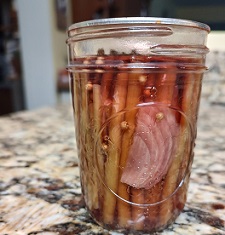Summer vegetable garden weeds can be a problem for gardeners. It’s too hot to check weed growth every afternoon. And we really only have a few vegetable plants which will survive the heat of a Florida summer. Deciding to let the garden beds go fallow for the summer, I water the stronger herbs and ignored the spent vegetable beds. A good cover crop would be great, if I only had the time.
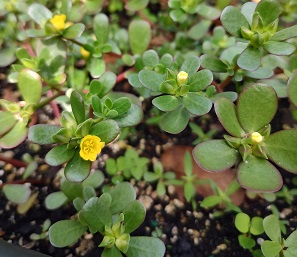
The Happy Accident
In early July, I discovered a “happy accident” in my garden. It was not the spent jalapeno pepper plants and lettuces which had surrendered to the heat. These vegetables were ready to be pulled. I kept putting off the task till evening or early morning- when it would be coolest. Several days of afternoon thunderstorms hindered my evening gardening. Early Saturday morning I finally headed out to conquer the task. And I noticed a happy accident.
My old beds of spent vegetables were taken over by a highly nutritious, drought tolerant, beautifully blooming batch of tasty, tender greens. I did not plant these greens, nor did I fertilize or water them. These plants volunteered, showing up all on their own. Enjoyment of these free, healthy, organic delicacies was made more so for those reasons. This plant thrived in the full hot summer sun. And there was enough of this vegetable for two different culinary preparations.
By now you’re asking, “What is it and where can I get some?”
This nutrient dense food plant which sowed itself into my garden and waited to sprout till the veggies were expired is… Purslane, Portulaca oleracea. The Latin name alone has culinary meaning. Port meaning “gate” referring to the seed covers and oleracea meaning “kitchen vegetable”.
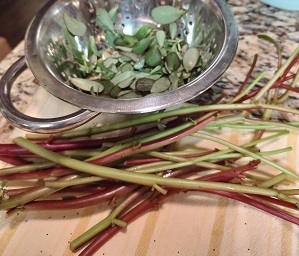
And these specimens in my plot were new, tender, unblemished and very robust.
Purslane
Purslane is highly nutritious and even contains Omega-3 fatty acids and antioxidants. The flavor is much milder than many greens in summer. All parts of the plant are edible. I use Purslane leaves as I would use fresh spinach in salads, smoothies, stir-fries, and omelets.
To add Purslane to an omelet, sautee a few mushrooms (if you like them) or chopped onions in a bit of coconut oil. Add the washed fresh purslane leaves to the pan once the mushrooms/onions are golden, right before adding the beaten eggs to the pan. When the eggs are just about ready, lightly sprinkle with sea salt and ground black pepper and serve. It is my favorite breakfast on a July Saturday morning.
While I was trimming the Purslane leaves off of their stems for use in my omelet, I set the stems aside to pickle them later. The Purslane stems are cut into 2-inch long pieces and packed tightly into a couple of sterilized, half-pint canning jars. I add some slivered onions to fill in any gaps. Pack them tightly! Then the hot, homemade pickle brine is poured over the stems in the jar. I then seal each jar with a canning lid and ring, and water-bath can them. My brine will be vinegar and water, lightly seasoned with honey and spices for a pickle just the way I like it. You can search “Pickled Purslane recipes” on the internet to find many different variations.
Getting to know your weeds
The University of Florida Institute of Food & Agricultural Sciences (UF/IFAS) Electronic Data Information Source (EDIS) has a 1-page publication on Purslane- Portulaca oleracea L. available for on their Ask ifas website.
Three years ago, after reading about purslane’s edibility on a blog called, “Eat the Weeds“, I got very excited. Mr. Deane is a botanist and his posts are very detailed. I had not realized that there were weeds I could eat. His website of the same name, eattheweeds.com, highlights the wonderful abundance of wild edibles we have all around us in the southeastern United States. I discovered that this weed vegetable is common in my neighborhood. I quickly learned that wild edible weeds vegetables may even be found in public parks, sidewalk cracks, and your very own lawn.
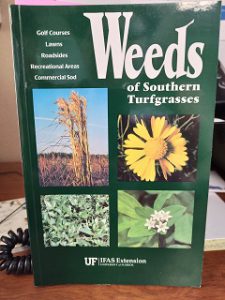
Foraging wild edible foods has been an interest of mine for most of my life. However, as a child, that interest usually revolved around the sweet alpine strawberries, Huckleberries, and wild blackberries which were abundant where I grew up. What child doesn’t know a good sweet when it catches them by the sleeve? But I had never thought about eating the leaves of the weeds in my yard.
NOTE: Never eat anything from the wild unless you can positively identify it as the correct edible species.
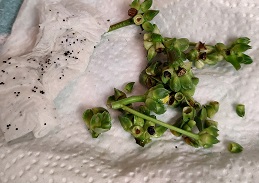
The book, Weeds of the Southern Turfgrasses, by the University of Florida Institute of Food & Agricultural Sciences (UF/IFAS) Extension is a good resource to positively identify most of our common Florida lawn weeds. Though this book will NOT tell you if a plant is edible, it has detailed photos of how these plants look in the Florida lawn and roadside for identification purposes.
What is a WEED?
But what is a weed? A weed is a “plant out of place”. Basically any plant which is where it is not wanted is a weed. My volunteer Purslane is definitely wanted. If you would like to collect purslane from your neighborhood, here are a few things to consider:
- Ask permission first if you want it from a property that is not your own
- Take purslane from a place where no chemicals have been sprayed or spilled
- Be sure no dogs or cats use the space where it is growing
- Do not take purslane from the edge of a busy road– tire pieces, exhaust fumes, oil, and leaking coolant are all common toxic chemicals along roadsides. Plants may take these toxins into their tissues, negatively affecting the healthfulness of your freely foraged vegetables.

Pickled purslane, Portulaca oleracea, and onions. Photo by Yvonne Florian, UF/IFAS IRC Extension Staff Assistant
If you can only find purslane plants near a busy roadside, consider taking the seeds home and planting them on purpose in your summer garden. They will come up every year once you have them with no more effort than it took to crush the seed capsule over your soil. It may be worth the time to get to know this and other free edible weeds in your neighborhood, or in your own back yard. They might just surprise you for lunch.
If you would like to learn more about canning your own pickles, please, do your research. The best place to start for beginners is the National Center For Home Food Preservation website. This site is the go-to place for all fully-researched home canning information.
 2
2
